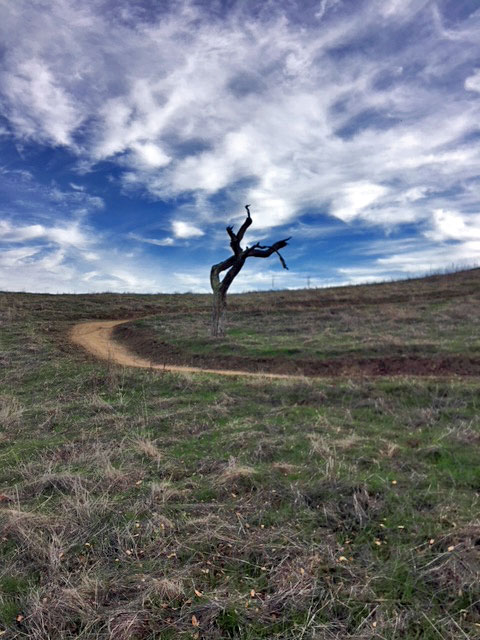Published in the December 6 – 19, 2017 issue of Morgan Hill Life

Photo by Robert Airoldi — A lone tree stands along the trail at the Coyote Valley Open Space Preserve.
It has been a year since I last walked the Open Space Authority’s Coyote Valley Preserve. I’ve been away too long, and I need a return visit — especially to check out the recently restored South Meadow.
This wetland rehabilitation project spans 8.5 acres and includes 500-feet of stream. It removed a series of agricultural drainage ditches. The restoration reconnected the stream and upper watershed to the valley floor regions, resulting is several ecological enhancements to the riparian and wet meadow habitat. Jake Smith from the OSA noted: “The landscape restoration would improve water quality and yield climate change benefits as well as providing for ground water recharge and flood control” infrastructure.
The northern portion of Coyote Valley has been news throughout much of 2017. The year started with a development proposal to build a major distribution facility just south of the Metcalf Energy Center at Blanchard and Monterey roads. If this project had been approved by the San Jose City Council, it might have been the opening salvo in a line of commercial buildings that could have sent south San Jose sprawling past Tulare Hill on the way to Bailey Avenue.
Several environmental organizations, including the OSA, have vigorously worked for the past few years to protect Coyote Valley from urban development, advocating that the landscape should serve as an open space corridor or linkage for wildlife. The Peninsula Open Space Trust acquired the 30-acre site in June from the developer and announced its enthusiastic participation in the effort to preserve nearly 1,000 acres of north Coyote Valley. This swath of land would connect the Santa Cruz Mountains at the Santa Teresa Hills with the Diablo Range at place known as Coyote Narrows. The two mountain ranges are so close to each other at this point that if there ever was a good place for a wildlife linkage — this is our best bet.
 All of Coyote Valley was at one time owned by the Fisher family, and later through marriage, the Murphy clan of Morgan Hill controlled sizeable plots for cattle grazing and hay farming. The Fisher’s property was known as Rancho Laguna Seca which referred to the seasonal lake that formed at the base of the Santa Teresa Hills near today’s IBM at Bailey and Santa Teresa. Old photos overlooking Laguna Seca from the early 1900s show an extensive wetland with marshes full of tule reeds forming a substantial habitat for wildlife. It was the largest freshwater wetland in Santa Clara County.
All of Coyote Valley was at one time owned by the Fisher family, and later through marriage, the Murphy clan of Morgan Hill controlled sizeable plots for cattle grazing and hay farming. The Fisher’s property was known as Rancho Laguna Seca which referred to the seasonal lake that formed at the base of the Santa Teresa Hills near today’s IBM at Bailey and Santa Teresa. Old photos overlooking Laguna Seca from the early 1900s show an extensive wetland with marshes full of tule reeds forming a substantial habitat for wildlife. It was the largest freshwater wetland in Santa Clara County.
Early on, Coyote Valley was recognized for its agricultural potential, but the first order of business was to get a handle on the water supply. So, in 1916, much of the original Laguna Seca was drained and ditched for pasture and orchards. Fisher Creek, which flows more than 12 miles in a northwesterly direction from Morgan Hill skirting the western edge of Coyote Valley, at one time supplied a number of seasonal wet meadows on its path to Laguna Seca. Today, most of Fisher Creek has been channelized and now is artificially directed into Coyote Creek. Fisher Creek meanders its way next to the entry to the OSA’s Coyote Valley Preserve at Hale and Palm.
The San Francisco Estuary Institute, an organization that has produced many reports about historical ecology in California, stated the “Coyote Valley, and Laguna Seca in particular, offer a rare opportunity to restore natural wetlands functions and provide a diverse wetland habitat mosaic.”
This restoration opportunity for the Fisher Creek riparian zone could see the “reestablishment of stands of California sycamores, Fremont cottonwoods and valley oaks.” The OSA has taken the first step in this process and I look forward to observing first-hand the work that has been accomplished in the South Meadow. Wouldn’t it be cool to see Great Blue Herons, Snowy Egrets and all varieties of ducks partaking in this restored wetland?
If the Arrowhead Trail is in good shape for the hike, we will be able to gain some elevation and look out over Coyote Valley with a fuller perspective for the potential this landscape has for wildlife, for green infrastructure and for our aesthetic enjoyment.
Wishing everyone a peaceful and wonder-filled holiday season. Keep on Sauntering!
Gilroy resident Mike Monroe is a Morgan Hill business owner and naturalist. He is a docent for Santa Clara County Parks.






